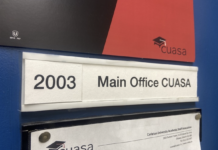Carleton University is facing a severe financial crisis, with a reported $50.1 million deficit for the 2023-24 fiscal year. This concerning figure has led university officials to caution the community students about incoming “significant measures” to try to restore budgetary balance.
Despite the alarming deficit, Carleton shows no signs of pulling back on ambitious, ridiculously costly initiatives that will plunge the school further into debt.
Given these high-cost initiatives, Carleton’s warning is a slap in the face to students, who are already paying the price for the university’s decisions.
The university’s “Campus Master Plan,” a sprawling 80-page vision document, proposes massive changes to campus design and infrastructure, including 28 potential new buildings and renovations to the Loeb Building.
Among its main features is the “Green Ribbon and Geological Time Trail,” a 4.6-kilometre, campus-wide pathway featuring sustainable infrastructure such as stormwater management systems and native landscaping.
Other initiatives in the plan include enhancing the tunnel system, with a desired addition being skylights to increase natural lighting, and reimagining streets like Campus Avenue to be more pedestrian-friendly.
But where on earth is the funding coming from for these mind-boggling capital expenditures? For context, the construction of the Nicol Building alone cost a staggering $65 million. Given this, imagine the cost of some of the projects in the master plan.
In addition, students recently voted on a proposed Fitness Centre expansion. If approved, the expansion would more than triple the facility’s footprint from its current 11,000 square feet to 32,000 square feet across two levels.
The new centre would feature enhanced cardio and weight training areas, four multipurpose rooms for fitness classes, a women-only fitness area and expanded common spaces. The estimated financing plan involves a loan with a 30-year repayment timeline.
A decades-long repayment is not uncommon for schools, with even Harvard University partaking, but the fact Carleton is willing to undertake that financial burden in such an uncertain time is baffling.
Further adding to the list of expenditures is the construction of the Rideau House building, expected to open in fall 2025. The nine-floor residence will include a fitness centre, a half-court gym, a theatre space and rooms for 450 students.
The extensive dining hall renovations from over the summer must be taken into consideration as well, which came with a steep $8.5 million budget.
That’s not all — Carleton is also negotiating with the City of Ottawa to build a new aquatics centre on campus. This proposed facility would feature a 50-metre competitive pool, a 25-metre warm-up pool and a community pool. The project is estimated to cost $54.6 million and is expected to take five years to complete.
Why is the school not putting these millions of dollars towards, say, mental health services for students or better transportation?
An amenity like a new clinic would provide immediate relief for students — unlike the master plan, the pool, or the athletics centre expansion. Many students studying at Carleton today will never even see those flashy bids to bolster enrolment.
As well, the school could put their money towards better pay for contract instructors, who were grossly misvalued during the CUPE 4600 strike. For context, in 2023, graduate teaching assistants were making roughly $11,000 — or $42.54 per hour — for full-year assignments, which, for many, was barely enough to cover tuition. Undergraduate teaching assistants were paid $24.51 per hour.
Out of around 2,100 TAs at Carleton, 93 per cent voted in favour of a strike mandate last year, displaying the widespread discontent with the university’s labour policies.
Carleton could easily pay those workers the wages they deserve and improve the quality of students’ education as a result. Instead, Carleton opted for showy projects that will only sink the university deeper into its sinkhole of a deficit.
While students brace for cuts and possible fee increases, the university continues to invest in extravagant projects, prioritizing expansion over financial responsibility — and their own students and instructors.
Featured graphic by Etta Gerrits.





